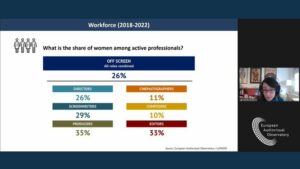
Women in AV production: Many challenges, but also impulses for change

On 6 December 2023, eight European organisations from the AV sector came together to co-host a webinar on “Women in European Audiovisual Production”.
The event was organised by EFAD – the European Film Agencies, EWA – European Women’s Audiovisual Network and Uni Global Union – the Union of Media, Entertainment & Arts; in partnership with The International Federation of Actors (FIA), Le Lab – Femmes de Cinéma, the European Audiovisual Observatory and the media outlet Cineuropa. FERA also supported the organisation.
During the webinar, which was moderated by Diversity, Inclusion & Equity Consultant Sarah Diedro Jordão, participants shared recent statistics and presented initiatives as well as best practices related to gender equality in the industry.
Iris Zappe-Heller, Deputy Director of the Austrian Film Institute, welcomed participants on behalf of EFAD. She gave some insights into the work of EFAD’s Gender and Inclusion Working Group, which she chairs: The working group monitors the presence of women in the AV sector on and off the screen, shares best practices and also facilitates online talks about more specific subjects, for example about the role of intimacy coordinators on set. Most notably, in collaboration with Eurimages, it has created the European map of diversity and inclusion, an important monitoring tool, which is regularly updated.
The introduction was followed by two presentations, the first one on the latest gender statistics by the European Audiovisual Observtory, presented by industry analyst Patrizia Simone, and the second one about Le Lab’s 2023 update to their qualitative study On the place of Female Directors in Europe, led through by Fabienne Silvestre and Lise Perrotet from Le Lab.
One of the key takeaways from the EAO presentation is that women are still unterrepresented in the industry, representing only roughly a quarter of the “behind the camera” workforce, all roles combined (from directors to editors). Only 10 per cent of European cinematographers are women.
There are, however, crucial geographical differences, with women being better represented in the German-speaking and Nordic countries. Moreover, women are also faced with a significant gender pay gap, partially explained with a disparity in production budgets: Feature films directed by women usually receive 19 per cent less funding, and documentaries 8 per cent less.
Le Lab is a think tank working on parity and mixity in the AV industry, that has been conducting a yearly study on Female Directors in Europe, since 2016, in collaboration with the EAO, EFAD, and supported by the French Ministry of Culture and CNC. The 2023 update of their study shows that, while there are challenges, there is also hope for change, as 15 countries have implemented or are currently developing measures to increase mixity and gender balance in screen industry professions.
In addition to that, 16 countries have committed to fight against gender-based and sexual violence in the sector, as a result of the #metoo movement. France is one of the forerunners in this respect and the CNC is currently setting up a new system, where funding for AV production is tied to the fulfillment of a specific set of obligations (e. g. participation in training courses on gender-based violence).
The event concluded with a panel discussion. The discussants where Enrico Vannucci (Deputy Executive Director, Eurimages), Daphné Tepper (Director of Policies, Media, Entertainment & Arts Sector at UNI Europa) and Dácil Roca (Board Member, MIA Mujeres en la Industria de la Animación).
Dácil Roca highlighted the contribution of the #metoo movement to make the reality of women’s position in the AV and animation sector more visible and increase public demand to see more content made by women. Daphné Tepper noted that, in order to implement action plans to eventually eliminate the gender pay gap, data on the remuneration levels of women and men in audiovisual jobs should be gathered and made publicly available.
Last but not least, Enrico Vannucci shared encouraging results of the Eurimages strategy for promoting gender equality, which has been adopted in 2013 and expanded to also focus on diversity in 2022. In only one decade, projects led by women supported by Eurimages have increased from 7% to 48%, showing that positive change is possible with the right approach.
You can find useful links and supporting documents below.
LINKS:
– Webinar video on the Cineuropa website
– Slides 1: European Audiovisual Observatory presentation on gender statistics
– European Audiovisual Observatory report on Female Professionals Active in the European Film Industry
– Slides 2: Le Lab presentation of their “Female Directors in Europe” study
– Study: Le Lab study Female Directors in Europe
– European map of diversity and inclusion

